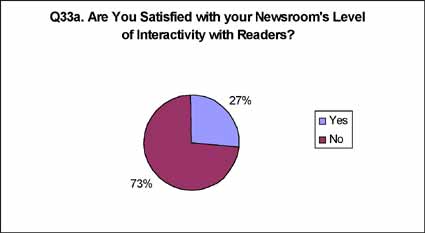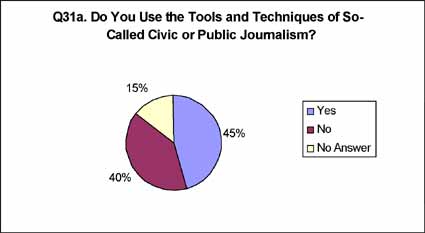Summer 2001
Journalism Interactive
Survey Pinpoints a Sea Change in Attitudes and Practices
Engagement Defines New Era of Journalism
U.S. newspapers report dramatic changes in the way they define and cover news and even how they view their mission, a new survey of the nation’s top editors reveals.
Key among the findings is that editors report a sharply increased appetite for more two-way connections with readers. Nine of 10 editors surveyed also say the future of the industry depends on even more interactivity with readers.

“This represents a sea change for a whole generation of journalists who joined the profession after Watergate, when the emphasis was on investigations and exposes,” said Jan Schaffer, Executive Director of the Pew Center for Civic Journalism. The Pew Center sponsored the survey, along with the Associated Press Managing Editors and the National Conference of Editorial Writers.
The unprecedented survey of all daily newspapers with circulations of 20,000 and more shows many papers are covering more topics than ever before. More than a third are covering more territory than ever before. Seventy percent of the newspapers responded.
“This survey tracks a hopeful and overdue trend in newsrooms,” said Chris Peck, APME President and Editor of The Spokesman-Review, in Spokane, WA. “Journalists are realizing their role is to connect with readers and interact with communities, not be disconnected and aloof.”
Peck released details of the survey on July 26 at a National Press Club luncheon in Washington,DC. Terence Smith, Media Correspondent and Senior Producer of The NewsHour with Jim Lehrer, helped lead the discussion.
“The poll reflects that newspapers finally have gotten the message that a press that too often emphasizes conflict and controversy to the exclusion of explanatory and public service journalism alienates readers,” said Jack Nelson, Chairman of the Pew Center’s Advisory Board and Chief Washington Correspondent for the Los Angeles Times.
“It’s a healthy development for the press and the public that there is an increasing emphasis on articles that better connect with readers and report on solutions as well as problems.”
The study shows that the new communication technologies and the new geography of journalism “are forcing news organizations to reassess what they do – and how they do it,” said Schaffer. “There is a higher comfort level for relinquishing traditional control and building journalism that is less of a one-way pipeline for information and more of a two-way conversation.”

Few editors in the survey describe their newspaper’s role in the community as simply a disseminator of facts. Eighty-seven percent say newspapers should have a broader role in the community beyond just printing news.
The editors rank “news explainer” first among six specific roles that newspapers can play. “News breaker” comes in second; “investigative watchdog,” third; “catalyst for community conversation” and “community steward” follow. The role of “disseminator of just the facts” finishes last.
“The report challenges us,” said Fred Fiske, NCEW President and Senior Editor of the Syracuse Newspapers. “Editors are not satisfied with efforts to date to increase reader engagement. Editorial page staffs across the country are equal to the challenge. They already are exploring new and creative ways to amplify that community conversation.”


Large majorities of editors say they now offer many entry points for readers to interact with reporters and editors. Interactive avenues include widespread use of e-mail addresses and phone numbers for reporters; tip lines for reader ideas; venues, aside from editorial pages, for readers’ own stories; and Web postings of news-gathering queries. More than half the respondents say they have convened conversations about a key community issue outside the newsroom.
“So much of current newsroom focus in journalism is on the ‘C’ word – convergence,” Schaffer said. “But this survey suggests the focus should be on a different ‘C’ word – citizens. The kinds of interactions with readers will then dictate the appropriate news platform.”
Editors who say they practice civic journalism, by actively seeking to engage readers in important community issues, are more likely than non-civic journalists to have adopted a variety of outreach mechanisms.
|
Q15. What other ways do you interact with your readers on ongoing coverage? |
||||||
|
|
Circulation |
C J Adherent |
||||
|
|
Total |
20,000-49,000 |
50,000-99,999 |
100,000+ |
Yes |
No |
|
E-Mail/Voice-Mail/Web Tip Line |
79% |
74% |
84% |
90% |
83% |
72% |
|
Op-Ed Community Forum Pages |
78% |
76% |
79% |
82% |
78% |
74% |
|
News Meeting Visitors |
51% |
47% |
53% |
62% |
62% |
38% |
|
Published Reader Feedback – Not Letters to the Editor |
50% |
48% |
51% |
57% |
56% |
44% |
|
Reader Articles |
47% |
49% |
45% |
41% |
48% |
45% |
|
Reader Advisory Boards |
42% |
40% |
46% |
41% |
47% |
36% |
|
Web Chat Groups |
27% |
14% |
35% |
57% |
31% |
20% |
|
Community Publishing |
16% |
16% |
15% |
15% |
17% |
15% |
|
Ombudsman/Reader Advocate |
15% |
8% |
12% |
44% |
18% |
13% |
|
Self-Publishing Opportunities |
9% |
11% |
3% |
10% |
9% |
7% |
|
Other |
20% |
24% |
12% |
21% |
23% |
21% |
Note: Respondents could check as many items as applied.
Forty-five percent of the editors surveyed say their newsrooms use both the tools and techniques of civic journalism. Sixty-six percent say they either embrace the label or like the philosophy and tools, suggesting that there are even more practitioners.

Nearly two-thirds of the editors say their newsrooms have formed partnerships with another local organization during the development of stories. The survey also shows considerable changes in the writing of stories. More than half the editors say they have made a conscious effort to move away from building their stories around a conventional frame of conflict. Among the new approaches:
- Roughly one-third indicate they prefer to frame their stories around the potential impact of a news event on people or the community.
- Eight in 10 say they offer stories about potential solutions to community problems at least some of the time.
- Forty-three percent say they make an effort, most of the time, to include the views of all potential stakeholders.
- Fifty-seven percent say, most of the time, they try to report trade-offs their community might have to make in addressing problems.
Among the editors, there is broad consensus that newspapers should make a conscious effort to include the views of all potential stakeholders in any given story. Slightly less than half of those queried say they always make the effort to ensure that all stakeholders are represented in their stories; another 43 percent indicate that they make the effort most of the time.
Fifty-eight percent of the editors indicate that their newspapers are diversifying sources or “voices” in their stories. Among the 207 editors who say their papers are doing so, 78 percent point to their development of new source lists, 15 percent indicate that their efforts include “civic mapping”-or systematically expanding their community Rolodexes-and 14 percent note the use of citizen reporters.
The need to connect more with readers has prompted considerable shifts in the topics covered by many daily newspapers. One-quarter of the editors say their papers are covering education issues more than they did five years ago; nearly that many say they’ve increased coverage of health, medicine and personal fitness over the last five years. In addition, 22 percent report increased coverage of business and personal finance; 21 percent report more coverage of growth and development.
To accommodate the emphasis on these new coverage areas, at a time when editors are also reporting cutbacks in staff, newspapers have made some tough choices. By far, the biggest loser in this equation is the coverage of government. Three-quarters of the editors say their papers are covering fewer routine government and school board meetings.
One editor explains his newspaper’s decision to scale back coverage of routine governmental meetings by volunteering: “Political pissing contests and personality conflicts – these things, unless they actually affect real people, are pointless.”
Surveyed were 512 U.S. dailies with circulations of 20,000 or more. Responses were collected via e-mail, mail and telephone and analyzed by the Campaign Study Group of Springfield, VA. Seventy percent, some 360 editors, responded. The “Journalism Interactive” survey was funded by the Pew Center for Civic Journalism, an initiative of The Pew Charitable Trusts. To read the poll, visit www.pewcenter.org.
